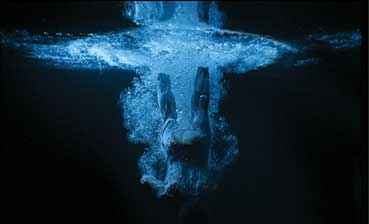Ahhhhh, chillerman . . . I see we may be on different wavelengths, my learned friend.
When you wrote, “the idea that more and more things I enjoy are becoming more and more intangible is something that often gets my attention”, it got me to thinking.
I understand the sentiment . . . and it IS becoming easier to engage with a digital culture that does not rely on object-ness. But half the fun is seeing where these worlds intersect, and the amazing art being created in the interstices.
In many respects a recent case in the U.K points out how ‘behind the times’ (an irrelevant phrase in itself if we see time as a fluid concept, not constrained to the ‘flowing river’ hypothesis) our institutions have been in coming to grips with the digital realm and too often clinging to outmoded notions of ‘value’ and (in?) materiality.
Seems the British courts have determined (at least for tax purposes) that work created by artists Bill Viola and Dan Flavin are more than the sum of its parts. The works in question were media art ‘sculptures’, installations involving screens, projectors, lights and digital media…

London’s Haunch of Venison gallery (okay, how fuckin’ good a name is that !) took the British Revenue and Customs agency to task for claiming the works of artists Bill Viola and Dan Flavin to be ‘electrical devices’, which covers ‘image projectors’ and ‘lamps and light fittings’.
The issue was whether six disassembled video installations by Bill Viola and a light sculpture by Dan Flavin could be imported by the Haunch of Venison gallery from the US into the UK as sculptures. At trial, HMRC (her Majesty’s Revenue and Customs) argued that the works were not art when disassembled into their various electrical component parts and crated for shipping. HMRC also sought to persuade the tribunal that the artistic element of Viola’s work was limited to the digital video data or the flat image projected onto the video screen. In other words, that Viola’s work lacked the three-dimensional qualities necessary to be regarded as sculpture. Haunch of Venison contended that as a matter of EU customs law (and on the facts), the installations should be treated as being sculpture upon importation.
This was a big move for the court, as the definition of “work of art” under EU custom law included only the term “sculpture” and had never been inclusive of film, video or other electronic and digital media. Haunch of Venison argued that sculptural practices had changed dramatically in the 2oth and 21st centuries and that “Viola and Flavin’s installations should be treated as sculpture. In particular, it was demonstrated how Viola specially customises digital video equipment in order to maximise the artistic impact of his installations and how his video screens are intended to be installed (according to precise instructions) in order to emphasise their three-dimensional qualities.” Bringing in curatorial “experts” to explain the practices of Flavin and Viola (now there’s an exchange I would love to have seen…as in “Excuse me young lady, are you saying these fluorescent tubes are to be compared with the exquisite canvases of Turner and Gainsborough . . . harrrumppphhh?”), Haunch of Venison was successful in persuading the Tribunal. What the court said was basically that all the component parts must be regarded as part of the overall work of art. The tribunal “[regarded] it as absurd to classify any of the works as components ignoring the fact that the components together make a work of art”.
That the media installations by Dan Flavin and Bill Viola were indeed sculptures represents an obvious truth . . . to you and I perhaps, and not worth further comment. But, for as staid and conservative institution as the British courts to see beyond AND within the materiality of the art form . . . well, I was . . . (a word I don’t often apply to myself) stupefied . . .
Now this may seem somewhat retrograde (and in many ways it is), but it does point to a critical dimension in media arts discourse that dogged early media arts acceptance into the gallery space to begin with – namely, making clear an objecthood often denied filmic and digital works . . . and haunts newer digital practices to this day. And, the arts institutions have nothing to be smug about. Note the reluctance of galleries to exhibit web based and other “new media” works.
Now, I don’t know what this means for the future of electronic and digital media art – if anything at all, but I like that we’re talking about it. Chalk one up for aesthetic materiality.
Until next time I remain, your (not so) humble servant,
Tripp Ayredale
Tags: courts, insurance, objectness, Tripp Ayredale, value